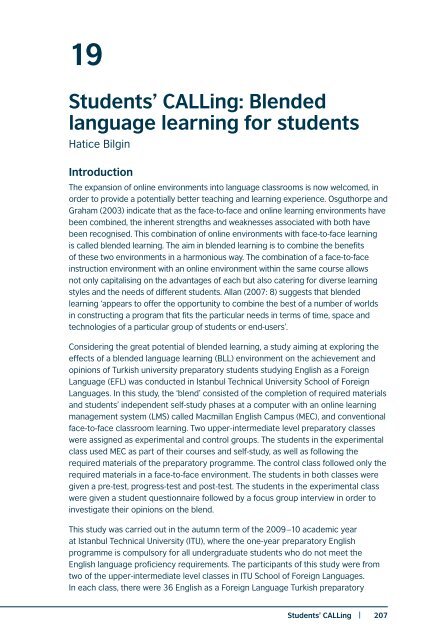Blended Learning in English Language Teaching: Course Design and Implementation
Blended Learning in English Language Teaching: Course Design and Implementation
Blended Learning in English Language Teaching: Course Design and Implementation
Create successful ePaper yourself
Turn your PDF publications into a flip-book with our unique Google optimized e-Paper software.
19<br />
Students’ CALL<strong>in</strong>g: <strong>Blended</strong><br />
language learn<strong>in</strong>g for students<br />
Hatice Bilg<strong>in</strong><br />
Introduction<br />
The expansion of onl<strong>in</strong>e environments <strong>in</strong>to language classrooms is now welcomed, <strong>in</strong><br />
order to provide a potentially better teach<strong>in</strong>g <strong>and</strong> learn<strong>in</strong>g experience. Osguthorpe <strong>and</strong><br />
Graham (2003) <strong>in</strong>dicate that as the face-to-face <strong>and</strong> onl<strong>in</strong>e learn<strong>in</strong>g environments have<br />
been comb<strong>in</strong>ed, the <strong>in</strong>herent strengths <strong>and</strong> weaknesses associated with both have<br />
been recognised. This comb<strong>in</strong>ation of onl<strong>in</strong>e environments with face-to-face learn<strong>in</strong>g<br />
is called blended learn<strong>in</strong>g. The aim <strong>in</strong> blended learn<strong>in</strong>g is to comb<strong>in</strong>e the benefits<br />
of these two environments <strong>in</strong> a harmonious way. The comb<strong>in</strong>ation of a face-to-face<br />
<strong>in</strong>struction environment with an onl<strong>in</strong>e environment with<strong>in</strong> the same course allows<br />
not only capitalis<strong>in</strong>g on the advantages of each but also cater<strong>in</strong>g for diverse learn<strong>in</strong>g<br />
styles <strong>and</strong> the needs of different students. Allan (2007: 8) suggests that blended<br />
learn<strong>in</strong>g ‘appears to offer the opportunity to comb<strong>in</strong>e the best of a number of worlds<br />
<strong>in</strong> construct<strong>in</strong>g a program that fits the particular needs <strong>in</strong> terms of time, space <strong>and</strong><br />
technologies of a particular group of students or end-users’.<br />
Consider<strong>in</strong>g the great potential of blended learn<strong>in</strong>g, a study aim<strong>in</strong>g at explor<strong>in</strong>g the<br />
effects of a blended language learn<strong>in</strong>g (BLL) environment on the achievement <strong>and</strong><br />
op<strong>in</strong>ions of Turkish university preparatory students study<strong>in</strong>g <strong>English</strong> as a Foreign<br />
<strong>Language</strong> (EFL) was conducted <strong>in</strong> Istanbul Technical University School of Foreign<br />
<strong>Language</strong>s. In this study, the ‘blend’ consisted of the completion of required materials<br />
<strong>and</strong> students’ <strong>in</strong>dependent self-study phases at a computer with an onl<strong>in</strong>e learn<strong>in</strong>g<br />
management system (LMS) called Macmillan <strong>English</strong> Campus (MEC), <strong>and</strong> conventional<br />
face-to-face classroom learn<strong>in</strong>g. Two upper-<strong>in</strong>termediate level preparatory classes<br />
were assigned as experimental <strong>and</strong> control groups. The students <strong>in</strong> the experimental<br />
class used MEC as part of their courses <strong>and</strong> self-study, as well as follow<strong>in</strong>g the<br />
required materials of the preparatory programme. The control class followed only the<br />
required materials <strong>in</strong> a face-to-face environment. The students <strong>in</strong> both classes were<br />
given a pre-test, progress-test <strong>and</strong> post-test. The students <strong>in</strong> the experimental class<br />
were given a student questionnaire followed by a focus group <strong>in</strong>terview <strong>in</strong> order to<br />
<strong>in</strong>vestigate their op<strong>in</strong>ions on the blend.<br />
This study was carried out <strong>in</strong> the autumn term of the 2009 –10 academic year<br />
at Istanbul Technical University (ITU), where the one-year preparatory <strong>English</strong><br />
programme is compulsory for all undergraduate students who do not meet the<br />
<strong>English</strong> language proficiency requirements. The participants of this study were from<br />
two of the upper-<strong>in</strong>termediate level classes <strong>in</strong> ITU School of Foreign <strong>Language</strong>s.<br />
In each class, there were 36 <strong>English</strong> as a Foreign <strong>Language</strong> Turkish preparatory<br />
Students’ CALL<strong>in</strong>g | 207


